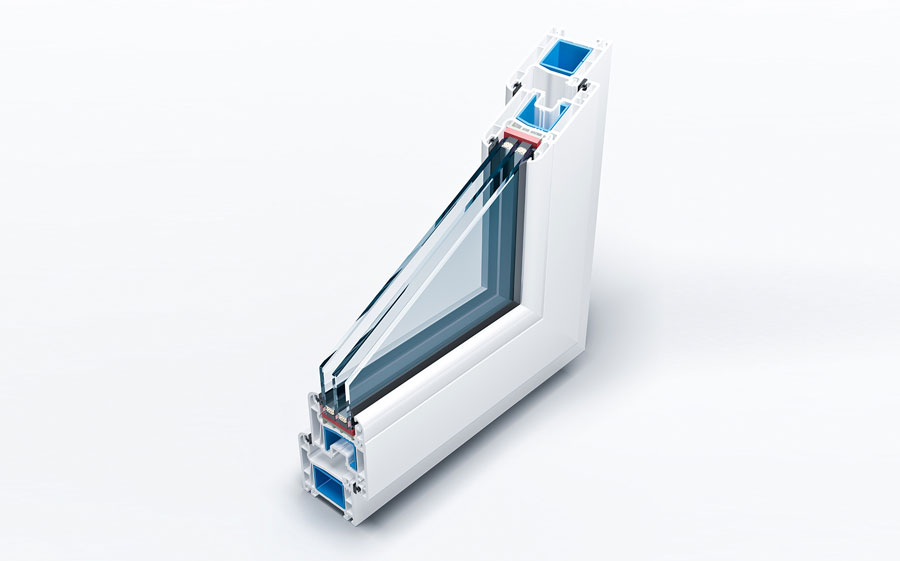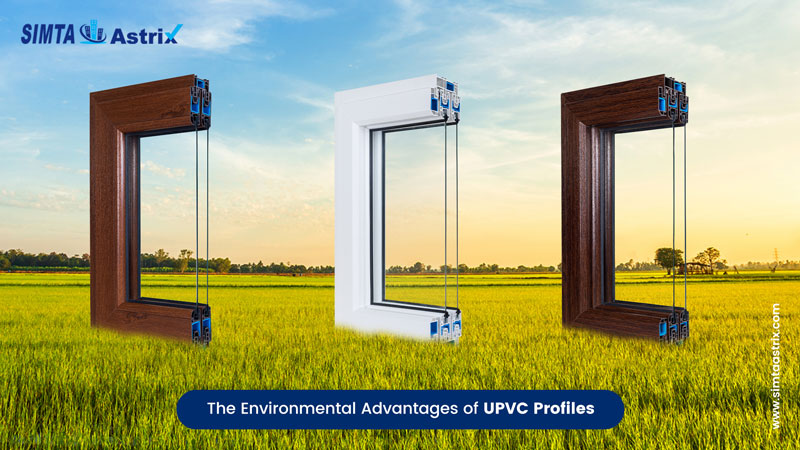Introduction
uPVC (unplasticized polyvinyl chloride) profiles have gained immense popularity in the construction industry, particularly for uPVC window frames. These profiles offer a range of exceptional qualities that make them durable, easy to maintain, and environmentally friendly. By understanding and appreciating the sustainable aspects of uPVC profiles, we can fully embrace their role in creating energy-efficient and eco-friendly uPVC window systems.
As the world faces pressing environmental challenges, finding sustainable solutions has become paramount. Consequently, the construction sector, known for its significant resource consumption and carbon emissions, has sought innovative materials and practices that minimize its environmental impact. In this context, uPVC profiles have emerged as a game-changer, revolutionizing how we approach window frame construction.
uPVC profiles are manufactured using unplasticized polyvinyl chloride, a rigid form of PVC that does not contain plasticizers. This composition enhances the profiles’ durability and stability while reducing their environmental footprint. As the construction industry increasingly prioritizes energy efficiency, uPVC profiles have proven to be effective, offering many environmental advantages.
This article will delve into the sustainable aspects of uPVC profiles, shedding light on their contributions to energy conservation, waste reduction, and overall environmental well-being. We will explore their durability, thermal insulation properties, recyclability, low maintenance requirements, and responsible manufacturing practices. By understanding these key aspects, we can make informed decisions and embrace uPVC profiles as a sustainable choice for uPVC window systems.
Incorporating uPVC profiles into our construction projects can significantly reduce energy consumption, lower carbon emissions, and minimize waste generation. In addition, these profiles offer a long lifespan, reducing the need for frequent replacements and conserving natural resources. Also, their excellent thermal insulation properties contribute to energy-efficient buildings requiring less reliance on artificial heating and cooling systems.
As we navigate a greener future, we must acknowledge the contributions of sustainable materials like uPVC profiles. By harnessing their environmental advantages, we can create buildings that are aesthetically pleasing and functional and aligned with our commitment to environmental stewardship. Join us as we explore the sustainable aspects of uPVC profiles and uncover their potential to transform the construction industry into an eco-friendlier and energy-efficient sector.

What are uPVC Windows Profiles?
uPVC window profiles are specially designed frames made from unplasticized polyvinyl chloride. These profiles form the foundation of uPVC windows, providing structural integrity, insulation, and aesthetic appeal. uPVC window profiles consist of multi-chambered designs that enhance thermal performance and can be customized to fit various window styles and sizes.
Environmental Advantages of uPVC Profiles
uPVC profiles offer a range of environmental advantages that make them a sustainable choice for window frames and other construction applications. Let’s delve deeper into these advantages and understand how uPVC profiles contribute to a greener, more eco-friendly future.
Energy Efficiency and Reduced Carbon Footprint:
One of the key environmental benefits of uPVC profiles is their exceptional energy efficiency. The multi-chambered design of uPVC window profiles acts as a thermal barrier, effectively preventing heat transfer. This means that during hot summers, the cool air from air conditioning systems stays indoors, while the warmth generated by heating systems is retained in colder months. By reducing the reliance on artificial heating and cooling, uPVC profiles help to minimize energy consumption and, in turn, reduce carbon dioxide emissions. This not only lowers utility bills but also contributes to mitigating climate change.
Sustainable Material:
Due to its composition and manufacturing method, uPVC is a sustainable material option for window profiles. Unlike conventional PVC, uPVC does not contain plasticizers, making it more resilient to deterioration caused by the environment. Furthermore, uPVC profiles can be manufactured using environmentally friendly additives and stabilizers, minimizing the use of toxic substances. The raw materials used in uPVC profile production can be sourced responsibly, minimizing the environmental impact throughout the supply chain.
Durability and Longevity:
uPVC profiles are known for their exceptional durability and longevity. Unlike wooden frames susceptible to rotting, warping, and insect infestations, uPVC profiles are highly resistant to moisture, corrosion, and pests. This durability extends the lifespan of uPVC window systems, reducing the frequency of replacements and the associated waste generation. By choosing uPVC profiles for window frame replacement, homeowners and businesses can make a long-term investment that reduces the consumption of natural resources and the environmental impact.
Recyclability and Circular Economy:
uPVC profiles are highly recyclable, contributing to the circular economy. At the end of their long lifespan, uPVC profiles can be recycled and used as raw material for manufacturing new profiles or other uPVC-based products. This recycling process significantly reduces the demand for virgin materials, conserves resources, and minimizes waste generation. Individuals and businesses can actively participate in the circular economy by choosing uPVC profiles, supporting a sustainable and closed-loop system.
Low Maintenance and Reduced Chemical Usage:
Compared to traditional window frame materials like wood, uPVC profiles require minimal maintenance. They do not require regular painting, varnishing, or sealing to protect them from the elements. uPVC profiles naturally resist moisture, rot, and fading, eliminating the need for toxic treatments or chemical coatings. This low-maintenance characteristic saves time and effort and reduces harmful chemicals’ release into the environment. Furthermore, the absence of chemical coatings on uPVC profiles ensures indoor air quality remains uncompromised.
Water and Air Tightness:
uPVC profiles offer excellent water and air tightness, preventing water infiltration and drafts. This characteristic enhances energy efficiency and contributes to a healthier living environment. By minimizing water infiltration, uPVC profiles help to prevent moisture-related issues such as mould growth, which can negatively impact indoor air quality and pose health risks. The superior air tightness of uPVC profiles also helps to reduce the entry of outdoor pollutants, allergens, and noise, promoting a cleaner and more comfortable indoor environment.
By considering the environmental advantages of uPVC profiles, individuals, architects, and contractors can make informed decisions that align with sustainable construction practices. uPVC profiles offer a range of benefits that contribute to energy efficiency, resource conservation, waste reduction, and the overall well-being of the planet. However, it is important to note that maximizing the environmental advantages of uPVC profiles requires a holistic approach and responsible practices throughout their lifecycle.
Responsible Manufacturing and Supply Chain:
To enhance the sustainability of uPVC profiles, manufacturers can adopt responsible manufacturing practices. This includes implementing energy-efficient production processes, minimizing waste generation, and reducing the use of harmful chemicals. Manufacturers can also prioritize sourcing raw materials from sustainable suppliers, ensuring that the supply chain aligns with environmentally conscious principles.
Additionally, manufacturers can invest in research and development to further improve the environmental performance of uPVC profiles. This may involve exploring alternative additives, developing innovative recycling methods, or integrating renewable energy sources into production. Finally, continuous improvement in manufacturing practices will reduce the environmental impact associated with uPVC profiles.
Proper Disposal and Recycling:
When uPVC profiles end their useful lives, they can be properly disposed of and recycled. Homeowners, contractors, and waste management companies are crucial in ensuring proper disposal practices. Recycling uPVC profiles involves collecting and processing the material to create new profiles or other uPVC-based products. This process reduces the demand for virgin materials, saves energy, and minimizes waste sent to landfills.
It is important to note that recycling uPVC profiles requires specialized facilities equipped to handle the material. Therefore, individuals and businesses should collaborate with certified waste management companies with the infrastructure and expertise to recycle uPVC profiles effectively. Furthermore, by choosing responsible disposal and recycling methods, the environmental advantages of uPVC profiles are extended, contributing to a more sustainable waste management system.
Education and Awareness:
Promoting education and awareness about the environmental benefits of uPVC profiles is vital for encouraging sustainable choices in the construction industry. Architects, contractors, and homeowners should be informed about the advantages of uPVC profiles in terms of energy efficiency, durability, recyclability, and low maintenance. This knowledge empowers individuals to make informed decisions when selecting window frames, considering their functional and environmental requirements.
In addition to education, policymakers can play a crucial role in promoting sustainable materials like uPVC profiles. For example, governments can foster a shift towards more sustainable construction methods by incentivizing sustainable construction practices, offering grants or tax benefits for energy-efficient solutions, and implementing green building codes.
Conclusion
uPVC profiles, particularly uPVC window profiles, provide numerous environmental advantages that make them a sustainable choice for the construction industry. Their energy efficiency, durability, recyclability, low maintenance requirements, thermal insulation, and sound insulation properties contribute to a greener and more sustainable future. By choosing uPVC profiles, we can minimize our ecological footprint, conserve resources, and create energy-efficient buildings. Embracing uPVC profiles is a step towards a more sustainable and eco-friendlier world.
As we continue to prioritize environmental sustainability, uPVC profiles stand as a shining example of how innovative materials and construction practices can contribute to a greener future.
The production and disposal of uPVC profiles might have an impact, even though they provide major environmental benefits. Therefore, manufacturers and consumers must ensure responsible practices throughout the entire lifecycle of uPVC profiles to maximize their sustainability benefits.
Manufacturers can concentrate on developing environmentally friendly production techniques, such as cutting back on energy use and trash output during production. They can also explore using recycled uPVC materials to produce new profiles, further closing the loop and reducing the reliance on virgin materials.

